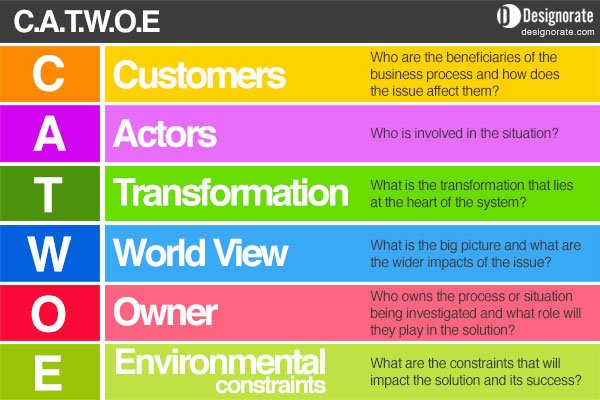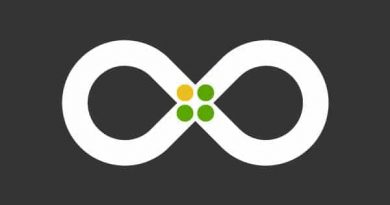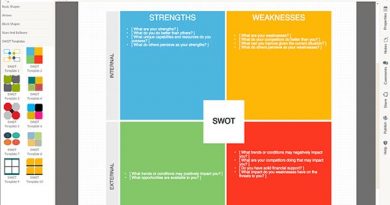CATWOE: Building a Problem-Solving Checklist
Problem solving is the main target of design thinking methods, and the previously discussed design thinking methods that are used in solving problems tend to work through a number of steps in order to reach a final solution for the problem. However, in particular situations, solving the problem isn’t the main target of meetings or discussions. Stakeholders simply would like to explore the problem and all the factors that relate to it in order to decide whether or not to take further actions.
Some design thinking tools, such as a cause-effect diagram, may be used for exploring problems, but this tool is designed to solve problems. Its steps and implementation time takes this into account. At this point, what managers need is a checklist that can give an insight about the problem without planning to solve it, such as the CATWOE.
In the 1960s, Peter Checkland, a system engineering professor, developed the Soft Systems Methodology (SSM) as a problem-solving method that uses system principles to solve business and “soft” problems. Later, in 1975, David Smyth, a researcher in the same department with Peter Checkland, observed that the SSM is more successful when considering certain elements: Customers, Actors, Transformation Process, World View, Owner, and Environmental Constrains, which are known collectively by the acronym CATWOE. The checklist uses the six mentioned elements to explore the system where the problem took place. Hence, the tool doesn’t intend to explore the problem itself, which makes it different from other tools.

How CATWOE Works
The CATWOE is used to explore the system through highlighting a root definition, which defines the system that involves converting the inputs into outputs. This can be achieved through defining the following five elements.
Customers (C)
The customer element represents the target of the product or service, such a consumers and users. In this portion, the team tends to understand more about the consumers, such as who the end consumers are, what problem they face, and how will they interact with the proposed solutions.
Actors (A)
The actors refer to everyone involved in the situation and who will take part of the solution. Actors can include stockholders and employees who are directly or indirectly involved in the project. This part involves asking questions such as: Who is involved in the project? Who is part of the solution? And how will this solution affect them?
Transformation Process (T)
What is the process that turns the inputs into outputs? The transformation should be defined by one single process. Defining multiple processes indicate a confusion in the transformation process.
Weltanschhaung (World View) (W)
This is considered the most important element in the CATWOE framework, as it tends to view the big picture of the situation. It also defines the highlighted problem and predicts the wider impact of the solution. An accurate definition for this element ensures clear understanding of the system.
Owner (O)
This element represents the person who has the power to control the system and decide whether it will be implemented or not. This person has full authority over the system. The owner also controls how to direct the system toward CATWOE framework directions and lead the whole system to solve problems.
Environmental Constraints (E)
This element represents the broader constrains and restrictions that may halt operating the system. This includes ethical issues, laws, and resources. Also, it includes the suggestions to get around these constrains to solve the problem.
Example of Applying CATWOE
The CATWOE analyzes the system and builds a holistic understanding that incorporates the different perspectives of the system elements in order to integrate solutions that fit these elements. In this example, an aviation company explores the possibility of adding advertisement on their airplanes. Based on analyzing the situation, a CATWOE checklist can be constructed as following:
- Customers (C): Passengers, advertising companies, marketing agencies
- Actors (A): cabin crew, engineers, designers, employees, executive team, and shareholders
- Transformation Process (T): the airplane display advertisements during the flight
- Weltanschhaung (World View) (W): Increase the aviation company profits to increase revenues
- Owner (O): the person who controls the system and can make the decision to implement the solutions
- Environmental Constraints (E): the airport regulations, local laws, and culture
CATWOE is a root definition checklist that allows problem solvers to build a holistic approach for the system and its elements from different perspectives. The important fact that should be considered when using the CATWOE checklist is that it provides understanding of the system, which can be later adopted in the problem-solving method, such as the Soft System Methodology (SSM) defined earlier. CATWOE elements should cover all incorporated elements that affect the system, such as the consumer, the internal team, the problem, how the problem is seen, the decision makers, and the external factors related to the problem.
The CATWOE checklist can be adopted to build understanding about the situation in isolation of the solution method. While it is initially created as part of the SSM methodology, it can still be adopted with other problem-solving tools and methods.






